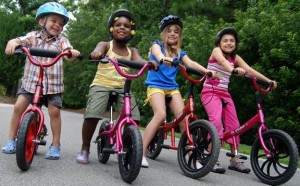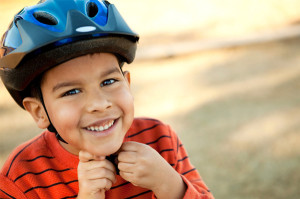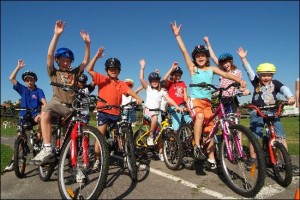A Successful and Safe Kids Bike Safety Day!
Blog Author: Ellie Rafoth, Community Engagement Intern
In July, Safe Kids of Akron Children’s Hospital and Mill Creek MetroParks teamed up to present Kids Bike Safety Day at Fellows Riverside Gardens! We had a great turn out! Kids of all ages came out to get fitted for helmets, learn important bike safety tips, and participate in a coloring contest!
 Demonstrating important bike safety was Mill Creek MetroParks’ Police Officer, Christian Hunter! Officer Hunter and I had a chance to talk about bike safety and he provided me well some additional facts and information about how kids can stay safe on their bikes this summer and into the fall.
Demonstrating important bike safety was Mill Creek MetroParks’ Police Officer, Christian Hunter! Officer Hunter and I had a chance to talk about bike safety and he provided me well some additional facts and information about how kids can stay safe on their bikes this summer and into the fall.
ER: Officer Hunter, why is bike safety so important?
CH: I think one of the reasons bike safety is so important is because of the sheer volume of people on bikes! Just about everybody has a bike, rides a bike, or comes into contact with people on bikes. This has led to 726 fatalities and 4900 injuries in 2012. Every year approximately 300,000 kids go to the emergency room and approximately 10,000 have injuries that require a few days in the hospital.
ER: What are the safety requirements for wearing a helmet?
CH: The bike helmet safety standard that is currently required by law in the United States is from the Government’s Consumer Product Safety Commission. A nonprofit organization called the Snell Memorial Foundation proposes higher safety standards. The details of these standards and the tests used in the process can be viewed on their websites. Wearing a helmet saves lives, and reduces the number and severity of injuries, but it’s important to make sure they fit properly. The helmet should be level on the head. When the rider looks up the front of the rim should be barely visible to them. The Y of the helmet side straps should meet just below the ears, if adjustable. The chinstrap should be tight enough that when the rider opens their mouth very wide the helmet pulls down a little bit. The skin around the rider’s eyebrows should move slightly when the helmet is moved front to back and side to side. If the helmet has a rear stabilizing strap, snug it up to the head. If you can put a palm against the front of the helmet and push the helmet up and back with a light push, more fitting is required. If the rider can shake their head around and dislodge the helmet adjust the straps more. Address any final comfort issues.
 ER: What are the safety requirements regarding the bike?
ER: What are the safety requirements regarding the bike?
CH: The bike is your vehicle. It’s important to have the right vehicle and make sure your vehicle is in proper operating condition to meet the demands that you and your environment put upon it. Stand on the ground with your bike between your legs. There should be 1-2 inches between you and the top tube of the bike or 3-4 inches if a mountain bike. The seat should be level and the seat height should be adjusted to allow a slight bend at the knees when the leg is fully extended. The handle bar should be approximately the same level as the seat. Check the condition of your vehicle. ABC QUICK. Check the AIR in the tires. Use a pressure gauge to compare your pressure of your tire with the number listed on the side of your tire. Make sure there is no obvious signs of damage to the tire or sidewall of the tire and make sure the treads are not too worn out. If the sidewall has “threads” showing, replace the tire immediately. Check the BRAKES. Hold the brake down and roll your bike back and forth. Check the pads for proper wear. Check brake cables and make sure they are not frayed anywhere and that they travel smoothly. Replace frayed cables and lubricate them and ensure they travel smoothly. Check the CRANK. It’s the bottom bracket, the crank arms, and the chain ring- basically the parts leading from your pedals into the bike. Grab a pedal and crank arm in each hand and try to move them sideways. If the both move you have a problem with the bottom bracket. If one moves there is a problem with the crank arm is most likely loose. Never ride a bike with a loose crank arm. Check the QUICK release on your front hub if you have them. You want them tight but not too tight. The proper pressure is obtained by pushing the lever just hard enough that it leaves an impression on the palm of your hand. Keep the lever pointed op when its closed sow it is less likely to catch on anything as you ride. Become familiar with further maintenance techniques, such as changing a flat tire, and practice them and carry a small bike tool kit in a pouch on your bike. Do not try to fix something you don’t understand. Walk the bike if needed and possible. Keep a cell phone in a bike pouch and use it if you need to!
ER: What should kids wear when riding their bikes?
CH: A helmet of course! Also wear bright colors. Not just bright but neon, fluorescent, or reflective clothing. White has been proven to not be visible enough. Reflective tape, stickers, or flashing lights are great. Put some tape or a rubber band around a pant leg that may become caught in a bike chain. Bike gloves protect the hands and polarized sunglasses help reduce glare on sunny days. Athletic shoes with good tread are okay for an occasional leisurely ride but nothing beats a dedicated bike shoe/cleat. Avoid flip flop/ open toe footwear or anything that fits poorly. Make sure a backpack, shoelace are anything else will not get caught in a chain. Don’t wear headphones. You need to hear your surroundings.
ER: Where should kids ride their bikes?
 CH: I like to see kids riding in areas with little to no traffic and with the supervision of an adult if possible. Kids need to check with their parents about where there allowed to ride and how far they can go and whether they can ride on the sidewalk or the street. Children under 10 are recommended to stay off the streets. The Mill Creek MetroParks offer an abundance of areas where vehicle traffic has been eliminated. These include the East Cohasset Drive Trail on the North side of the Park, the East Golf Trail on the South side of the Park and the 10.6 mile MetroParks Bikeway that extends through Canfield and Austintown. Vehicle traffic has been reduced to one lane on the East Newport Drive on the East side of the Park. With the Mill Creek MetroParks and other parks and bike paths in our area, there are many safe, beautiful places to ride your bike. People should to choose to utilize locations like these more often. Kids should not ride at night. You always need to watch for hazards. There are basically 3 types: surface, visual, and moving. Common surface hazards include holes/cracks, curbs, loose sand/dirt/gravel, drainage grates, puddles, etc. Common visual hazards include sun/glare, parked or moving vehicles, landscape/ vegetation, buildings, pedestrians, weather conditions [fog/smoke/wind], reduced light/darkness, etc. Common moving hazards include motor vehicles, other cyclists/ wrong way cyclists, open car doors, “parked” cars pulling in or backing out, pedestrians, dogs/animals. Even on a bike trail you may encounter a lot of these hazards. Keep in mind that that dog on a leash may run 6 feet or more in front of your path. Stay as far to the right as you safely can and don’t ride against the flow of traffic. That other person you are passing will probably not see or hear you coming so say ” passing on the left” ahead of time. A bike horn or bell is great to let people hear you coming. People tell kids to be quiet a lot. When you’re on your bike it’s a good time to let yourself be heard! Make some noise!
CH: I like to see kids riding in areas with little to no traffic and with the supervision of an adult if possible. Kids need to check with their parents about where there allowed to ride and how far they can go and whether they can ride on the sidewalk or the street. Children under 10 are recommended to stay off the streets. The Mill Creek MetroParks offer an abundance of areas where vehicle traffic has been eliminated. These include the East Cohasset Drive Trail on the North side of the Park, the East Golf Trail on the South side of the Park and the 10.6 mile MetroParks Bikeway that extends through Canfield and Austintown. Vehicle traffic has been reduced to one lane on the East Newport Drive on the East side of the Park. With the Mill Creek MetroParks and other parks and bike paths in our area, there are many safe, beautiful places to ride your bike. People should to choose to utilize locations like these more often. Kids should not ride at night. You always need to watch for hazards. There are basically 3 types: surface, visual, and moving. Common surface hazards include holes/cracks, curbs, loose sand/dirt/gravel, drainage grates, puddles, etc. Common visual hazards include sun/glare, parked or moving vehicles, landscape/ vegetation, buildings, pedestrians, weather conditions [fog/smoke/wind], reduced light/darkness, etc. Common moving hazards include motor vehicles, other cyclists/ wrong way cyclists, open car doors, “parked” cars pulling in or backing out, pedestrians, dogs/animals. Even on a bike trail you may encounter a lot of these hazards. Keep in mind that that dog on a leash may run 6 feet or more in front of your path. Stay as far to the right as you safely can and don’t ride against the flow of traffic. That other person you are passing will probably not see or hear you coming so say ” passing on the left” ahead of time. A bike horn or bell is great to let people hear you coming. People tell kids to be quiet a lot. When you’re on your bike it’s a good time to let yourself be heard! Make some noise!
ER: Any final “rules of the road?”
CH: Some “rules for the road” to help kids and anyone else: Always keep your hands on the handlebars. Stop and look both ways before you leave your driveway/alley/curb. Walk your bike across busy intersections using the crosswalk and follow the traffic signals. Ride as far to the right as safely possible, going the same way as traffic. Never ride against the flow. Use bike lanes or designated bikeways whenever you can. Don’t get too close to parked cars because the car door can open quickly. Ride single file. Be predictable- do not swerve or change direction quickly if you do not need to. Bikes are vehicles. Bikes are subject to the same rules as cars and other vehicles. That means among other things, you have to obey the traffic signs and traffic laws.
Learn hand signals and use them when you safely can.
Biking is a great way to travel, exercise and just have fun! Learning to ride a bike, and do it safely, is part of growing up. Apply what you have learned every time you ride your bike. Mill Creek MetroParks Police might see a child wearing their bike helmet, and when they do, they might just give them a “Sweet Citation” for a free Dairy Queen ice cream cone!
Thank you Officer Hunter for some really great tips on staying safe while riding a bike! Just because Kid’s Bike Safety Day is over doesn’t mean you shouldn’t practice proper safety procedures. Continue to wear your helmet and demonstrate appropriate bike safety and earn a free cone!
